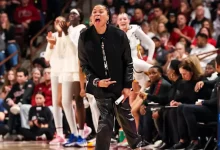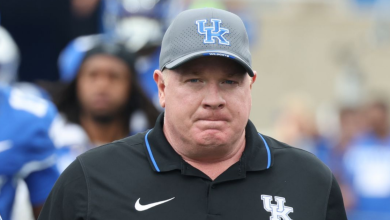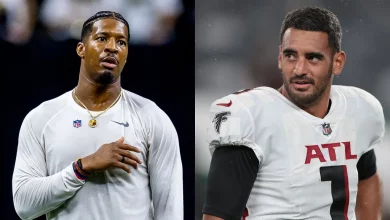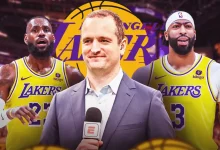Kyrie Irving injury update: Mavericks’ Jason Kidd updates his timeline to return Irving, 33, tore his ACL in early March
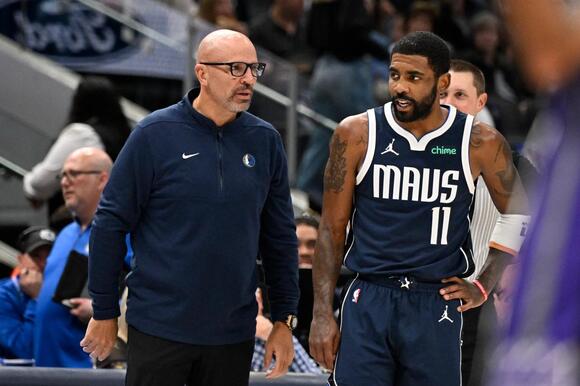
In March 2025, the basketball world was rocked when it was confirmed that Kyrie Irving, the star guard for the Dallas Mavericks, had suffered a season-ending ACL injury. This injury, sustained during a seemingly routine play in a game against the Sacramento Kings, left fans, teammates, and coaches in shock. While the specifics of the injury were gradually revealed, the nature of the incident and the impact it would have on both Irving’s career and the Dallas Mavericks’ chances for the remainder of the 2024-2025 NBA season became the focal point of many discussions.
The Injury: What Happened to Kyrie Irving?
Kyrie Irving’s ACL tear was diagnosed following an innocuous moment in the game against the Sacramento Kings. Known for his exceptional ball-handling skills, Irving had been maneuvering through traffic when his left knee buckled awkwardly. At first glance, it seemed like a minor injury, one that would be addressed with a brief pause or a trip to the locker room. However, after an immediate evaluation, it became clear that Irving’s injury was more serious than anyone had anticipated. The final diagnosis confirmed an anterior cruciate ligament (ACL) tear, an injury that would require immediate surgery and, more importantly, end Irving’s season.
An ACL tear is one of the most severe injuries a basketball player can endure. The ACL is responsible for stabilizing the knee joint, and any significant tear typically leads to an extended period of recovery and rehabilitation. For players like Irving, who rely heavily on speed, agility, and cutting ability, this injury presents a major obstacle.
Irving’s ACL injury marks a difficult moment in his career. Over the years, he has been one of the most electrifying guards in the NBA, known for his dazzling skills on the court. The injury raises questions about how it will affect his play moving forward, as ACL tears often require months of recovery and rehab to ensure full recovery.
Jason Kidd’s Update and the Timeline for Recovery
As the head coach of the Dallas Mavericks, Jason Kidd was quick to address the situation after the injury occurred. In his press conferences following the injury, Kidd expressed sympathy for Irving, acknowledging that the star player’s misfortune was unfortunate for both him and the team. The Mavericks coach was clear in his message to the media, stating that the injury was not due to overuse or any previous workload issues.
“This was a freak accident,” Kidd explained. “Kyrie has been working hard, but this injury just happened in an unfortunate way. There was no indication that his workload or anything else was a contributing factor.”
This comment was important because Irving had been under close scrutiny for his playing time, especially after some critics suggested that heavy minutes could be a cause for potential injury. However, Kidd emphasized that it was just an unpredictable, random incident, which helped alleviate concerns about overuse.
The timeline for Irving’s return remained uncertain, but Kidd and the Mavericks’ medical team made it clear that Irving would be sidelined for the remainder of the season. While ACL injuries can vary in recovery time, most players typically require at least six to nine months to recover fully and return to competitive basketball. For Irving, this meant he would miss the entirety of the 2024-2025 NBA season, which was already a pivotal one for the Mavericks.
Given Irving’s style of play, which is highly dependent on his agility and explosiveness, the recovery process would need to be gradual and cautious. Any premature return could risk further damage to his knee, so the Mavericks organization would have to be patient with Irving’s rehabilitation.
The Impact on the Dallas Mavericks
Irving’s injury is a major setback for the Mavericks, who were counting on him to be a critical part of their championship aspirations. The Mavs had made significant moves during the offseason to bring Irving onto the roster, partnering him with superstar Luka Dončić in what was expected to be a dynamic backcourt duo.
The Mavericks had high hopes that the pairing of Irving and Dončić could elevate the team to new heights. While Dončić had already cemented himself as one of the league’s brightest young stars, Irving’s unique skill set provided a perfect complement to Dončić’s all-around game. Irving’s ability to create his own shot, score from anywhere on the court, and create opportunities for teammates was expected to help the Mavericks push deep into the playoffs.
However, with Irving now sidelined, the team would need to adjust and reassess its approach to the rest of the season. The Mavericks were no longer in a position to rely on their newly formed star duo to lead them to the promised land. Instead, they would need to lean more on Luka Dončić, who now became the focal point of the team’s offense.
This shift also put a strain on the Mavericks’ depth. While Dončić is capable of carrying a team, he cannot do it alone. The Mavericks’ supporting cast would need to step up, and the front office might need to make trades or sign free agents to help fill the void left by Irving’s absence. The injury undoubtedly had long-term ramifications for the Mavericks, not just for the current season but also in terms of their roster construction and future plans.
What Does This Mean for Kyrie Irving’s Future?
The injury raises important questions about Kyrie Irving’s long-term future in the NBA. ACL injuries are notoriously difficult to recover from, and they can have a lasting impact on a player’s career. For Irving, who is already 32 years old, this injury could be a turning point. While many players have successfully returned from ACL tears and continued to play at a high level, the nature of the injury means Irving will need to put in the work to regain his previous form.
It is important to note that Irving has had a career filled with highs and lows, both on and off the court. He is undoubtedly one of the most gifted players to ever play the game, but his career has also been marred by controversy and injury concerns. Irving has often been the subject of off-court drama, and his playing time has sometimes been limited due to injuries or personal decisions.
This ACL injury will test Irving’s resilience and determination. If he can come back from it and return to his elite level of play, it would cement his place as one of the greats of his generation. However, if his recovery is slower than expected, or if he suffers any setbacks, it could further complicate his legacy.
For the Mavericks, Irving’s future with the team could also be in jeopardy. The team’s decision to invest heavily in Irving’s signing was based on their belief that he could be the piece needed to put them over the top. If Irving’s recovery takes longer than expected or if his career is impacted by the injury, the Mavericks may have to rethink their plans and consider alternative options for the future.
The Road to Recovery: What’s Next for Irving?
Kyrie Irving’s path to recovery will not be easy. After undergoing surgery to repair his torn ACL, Irving will begin the long rehabilitation process, which typically takes several months. The first phase of recovery will involve rest and physical therapy to reduce swelling and strengthen the muscles around the knee. As the months progress, Irving will gradually begin more intense physical therapy and conditioning exercises, aimed at restoring strength and flexibility to his knee.
Once he is cleared for full activity, Irving will likely need additional time to regain his basketball form. The mental aspect of returning from such a serious injury can often be just as challenging as the physical recovery. Irving will need to work closely with medical professionals, coaches, and trainers to ensure that his knee is fully healed and that he can return to the court at full strength.

